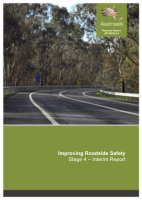Road Safety

Improving Roadside Safety: Stage 4: Interim Report
- Publication no: AP-R436-14
- ISBN: 978-1-925037-47-0
- Published: 12 February 2014
- PDF (free) Download
Roadside hazards pose a major risk to the occupants of vehicles which run off the road. This report presents the final stage of an Austroads project which involved investigations into the effectiveness of safety barrier placement, providing more forgiving roadside structures (such as frangible poles) or protecting errant vehicles against impacts with them (clear zones). It also investigated retrofitting of safety barriers to improve motorcyclist safety. The report presents road safety engineering practitioners in Australia and New Zealand with updated advice on hazard management, treatment selection and barrier placement to assist in making progressive steps towards safe roadsides.
- 1. Introduction
- 1.1. Aims and Objectives
- 1.2. Purpose
- 1.3. Project Structure
- 1.4. Stage 4 Scope
- 2. Methodology
- 2.1. Stakeholder Consultation
- 2.2. Crash Prediction Models
- 2.2.1. Selected Methodology
- 2.2.2. Characteristics of the Roadside Feature Data
- 2.2.3. Initial Statistical Analysis
- 2.2.4. Final Statistical Analysis
- 2.3. Effectiveness of Roadside Treatment Options – Literature Update
- 2.4. Effectiveness of Roadside Treatment Options – Data Analysis
- 2.4.1. Calculation of CMFs for Selected Treatment Options
- 2.4.2. Error Analysis
- 2.4.3. Rural Divided Road Analysis
- 2.4.4. Safety Barrier Offset Analysis
- 2.5. Analysis of Severity – Roadside Hazards and Treatment Options (FSI Crash Ratios)
- 2.5.1. Development of a Project Database
- 2.5.2. Calculation of FSI Crash Ratios
- 2.5.3. Error Analysis
- 2.6. Analysis of Severity – Frangible and Non-frangible Poles (FSI Crash Ratios)
- 2.7. Analysis of Severity – Safety Barriers
- 2.7.1. Development of the Barrier Project Database
- 2.7.2. Calculation of FSI Crash Ratios for Safety Barriers
- 2.8. Analysis of Severity Using All-severity Crash Data
- 3. Stakeholder Consultation
- 3.1. Clear Zones and Other Roadside Treatments
- 3.2. FSI Ratio vs FSI Crash Ratio
- 3.3. Selection and Placement of Safety Barriers
- 3.4. Framework for Guidance on Roadside Safety Management
- 3.5. Economic Evaluation
- 4. Crash Prediction Models
- 4.1. Introduction
- 4.2. Initial Statistical Analysis
- 4.3. Final Statistical Analysis
- 5. Effectiveness of Roadside Treatment Options
- 5.1. Literature Reviews
- 5.1.1. Consideration of Mean Speeds
- 5.1.2. Safe System and Barriers
- 5.1.3. Current Australian and New Zealand Guidance
- 5.1.4. Maintenance Considerations in Barrier Performance
- 5.1.5. Crash Reduction Effectiveness of Barriers
- 5.1.6. Review of Safety Barrier Test Performance Standards
- 5.1.7. Selection of Barrier Performance Levels
- 5.1.8. Placement of Barriers
- 5.1.9. Median Barriers
- 5.1.10. Barriers for Heavy Vehicles
- 5.1.11. Motorcyclist Barrier Solutions
- 5.1.12. Point Hazard Barriers and Attenuators
- 5.1.13. End Treatments and Transitions
- 5.1.14. Summary of CRF and CMF Findings from Literature Reviews
- 5.2. Data Analysis
- 5.2.1. Rural Divided Roads: Hazard Offset Distance vs Hazard Severity
- 5.2.2. Placement of Barriers – Crash Likelihood
- 6. Analysis of Severity of Roadside Hazards and Treatment Options
- 6.1. Relevant Findings from Stages 1 to 3
- 6.2. Data Analysis – All Results
- 6.3. Data Analysis of Frangible and Non-frangible Poles
- 6.4. Data Analysis of Safety Barriers
- 6.4.1. Relevant Findings from Stages 1 to 3
- 6.4.2. FSI Crash Ratios for Different Barrier Types
- 6.4.3. Placement of Barriers – Crash Severity
- 6.4.4. Analysis of Heavy Vehicle Crashes into Barriers
- 6.5. Data Analysis of All-severity Crashes
- 6.5.1. Crash Severity Odds Ratio Analysis
- 6.5.2. Injury Severity Analysis of Single-vehicle Run-off-road Crashes
- 6.6. Interpretation of FSI Crash Ratios
- 6.6.1. Comparison across Road Stereotypes
- 6.6.2. Comparison of Roadside Hazards and Treatment Options across Road Stereotypes
- 6.6.3. Comparison between Jurisdictions
- 7. Discussion
- 7.1. Crash Prediction Models
- 7.1.1. Time Series Issues
- 7.1.2. Data Categories
- 7.1.3. Model Quality and Usefulness
- 7.1.4. Comparison with Stage 2 Results
- 7.1.5. Broader Application of the Findings
- 7.2. Effectiveness of Roadside Treatment Options
- 7.3. Analysis of Severity of Roadside Hazards and Treatment Options
- 7.3.1. Unexpected Results
- 7.3.2. Potential Over-estimation of Some FSI Crash Ratios
- 8. Summary and Conclusions
- References
- Appendix A FSI Crash Ratios (Alternative)
- Appendix B Additional EastLink analysis results
- B.1 Additional Odds Ratio Analysis Results
- B.2 Additional Analysis for Relative Severity of Hazard Types
- B.3 Casualty Proportion Analysis
- Appendix C Comparison of FSI Crash Ratios Across Jurisdictions
Related publications
WEB-ZRT-24
Latest Road Safety News
